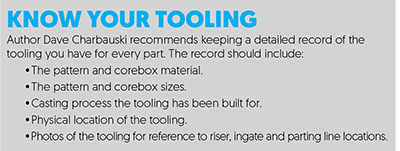Does My Tooling Transfer?
As a buyer of castings, you eventually will find yourself in the situation where you need to change foundries. In terms of the tooling required to make your castings, you will have two choices: build new tooling or move the existing tooling to the new source. Moving existing tooling is usually the most common choice; after all, you own the tool so you can choose where it goes. Seems like moving it should be a simple task, doesn’t it? With good planning and forethought, it can be relatively easy, but there are many factors that must be considered.

Let’s assume that you have already decided to move to a foundry that makes similar castings in your metal of choice, size and weight range, and level of complexity. The first obvious question is: “What tooling do I currently have?” Casting buyers should always keep detailed tooling descriptions. This will be good to have when changing sources and will be invaluable if you have an urgent need, such as a foundry suddenly curtailing business. At the minimum, the tooling description should record the pattern and corebox material, size, process it has been built for, and its physical location. Photos of the tooling are also important to have as they are good reference materials for riser, in-gate, and parting line locations.
If you move your pattern to a foundry that is running the same molding machine and flask size, there will probably be some slight changes required to produce the castings at that foundry. These are referred to as rigging changes. The location of the sprue on the pattern is a very common change. Sprue locations are often dictated by the ability to reach the sprue with the pouring ladle, the shape of the mold weight on the cope, and the available space on the squeeze head on automated molding machines. These three issues cause enough variation between foundries that you can almost guarantee that the sprue location will change.
Perhaps the new foundry runs a different type of molding or core machine. Then the question becomes one of tooling adaptability. Many times, the pattern can be adapted to a slightly different flask size by welding material to the pattern plate in the case of metal matchplates, or remounting pattern impressions on a new plate.
In the case of cope and drag patterns, there seems to be a wide variety of different flask sizes used by foundries, so the chances of your patterns fitting without changes will be rather slim. Remounting the patterns into a different flask size cope and drag set is a possibility, and remounting patterns to a matchplate can also be done. Another option is the creation of a bolster plate which allows a smaller pattern to be mounted into a larger flask.
Changing the molding process from green sand to nobake may be a solution for cope and drag patterns as they are very adaptable to the nobake molding process. However, there will be some slight dimensional differences in your casting when changing from green sand to nobake. The nobake process produces a much more rigid mold, so there is a tendency for the casting to be slightly smaller. This can create issues with machined surfaces on castings that only have a minimum amount of machine stock, or it can create potential issues with dimensions taken from locator surfaces. These issues can be controlled, but it may take some time to adjust the pattern equipment or the machining program/fixtures to compensate, so it is important to consider this dimensional variation.
Cores generally tend to be less of a problem since core boxes can usually be adapted to work with other machines or processes. In some cases, commercial core suppliers can be used to produce a core for the foundry. However, there can be issues with transporting fragile cores back to the foundry, so a good packaging plan will be necessary.
Be aware that there will likely be a charge associated with setting up the pattern and core equipment at a different foundry. The main point is that there is a good possibility that you can move your tooling to a different foundry without too many problems if you have planned well. CS
Click here to see this story as it appears in the March/April 2020 issue of Casting Source.